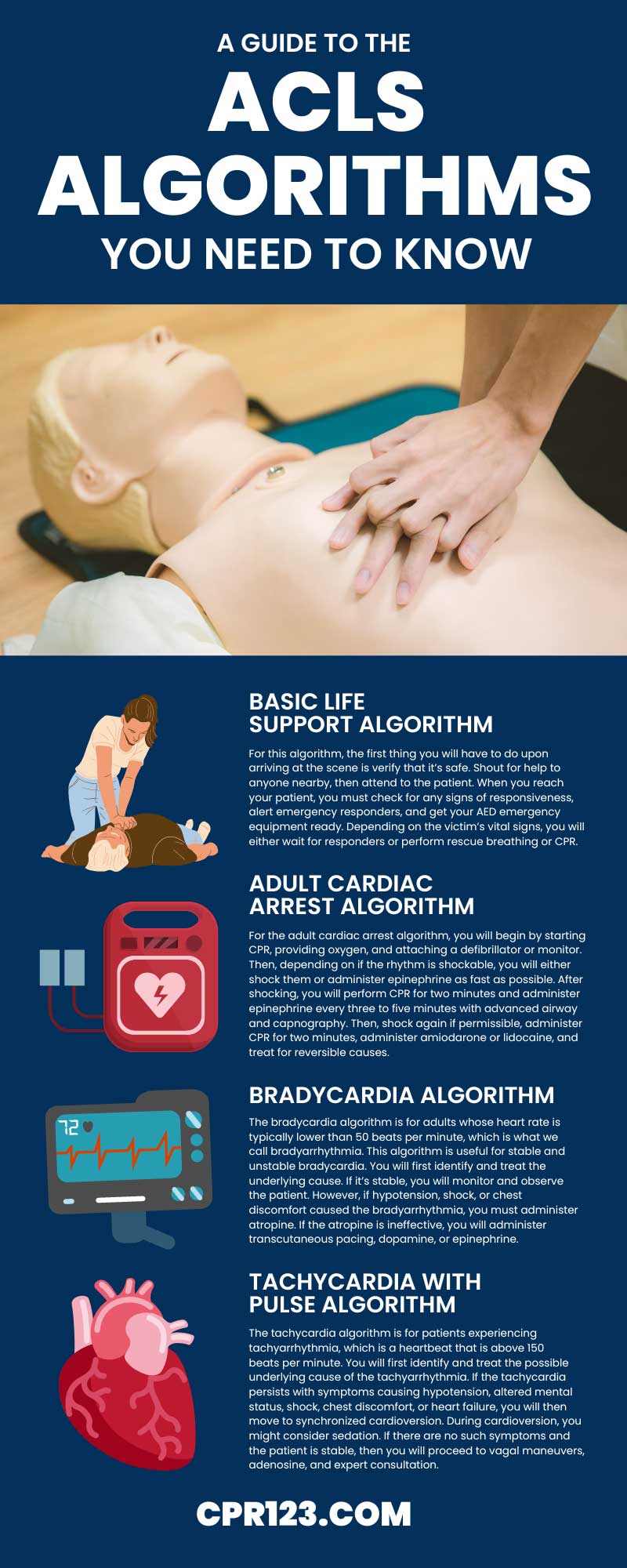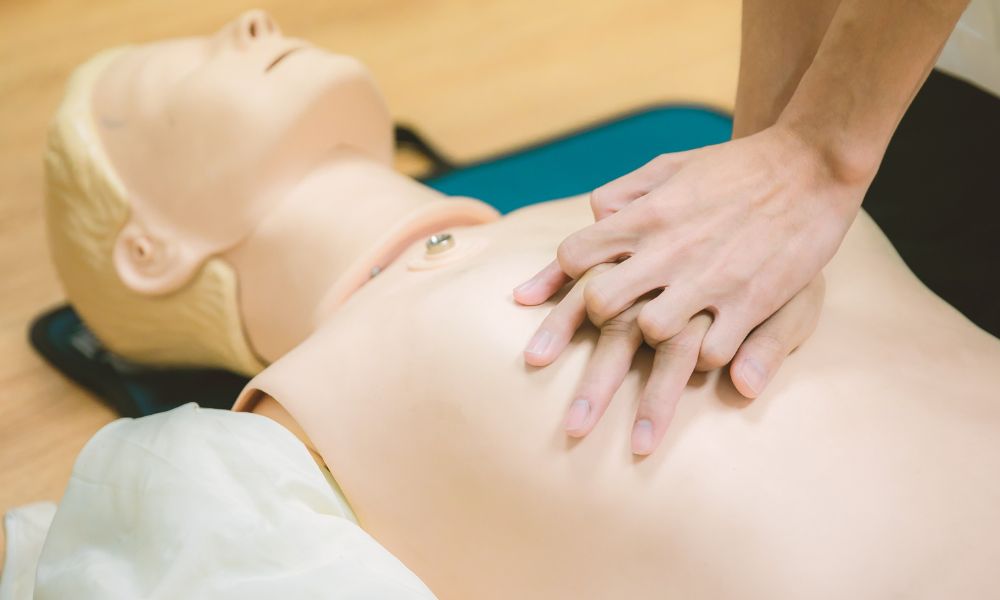Becoming a health-care provider requires a plethora of education that equips the person to perform their job correctly and efficiently. The education they receive will change depending on their role in the medical field. However, before they branch out further into their specialties, most health-care providers will need to obtain their ACLS certification. Luckily, we created this useful guide to the ACLS algorithms you’ll need to know for anyone studying for their exam.
What Is ACLS?
ACLS is the acronym for Advanced Cardiac Life Support, and it’s a course that many health-care professionals must take. It’s particularly essential for anyone whose role relates to cardiopulmonary arrest, cardiopulmonary emergencies, and emergency response.
Before taking the ACLS class, it’s important to have foundational health-care knowledge to be able to understand the information that you learn in this course. It builds upon Basic Lifesaving Skills, so it’s useful to have that working knowledge before entering this course. In fact, instructors generally expect you to know those skills beforehand. However, a BLS certification isn’t a requirement to take this course.
What Does ACLS Teach?
During our ACLS course, we will teach you everything that you’ll need to know to manage cardiac-related emergencies. Some skills that you must learn include:
- Basic Life Support Skills
- Early management of respiratory and cardiac arrest
- Recognition and early management of peri-arrest conditions, such as symptomatic bradycardia
- Airway management
- Related pharmacology
- Management of acute coronary syndromes and stroke
- Effective communication, how to lead a resuscitation team, and effective team dynamics
In addition to this information, you must also learn the different ACLS algorithms. That’s why we have provided this guide to the ACLS algorithms you need to know.
What Are ACLS Algorithms?
By the time you finish taking our course, you will understand ACLS algorithms, but right now, you might be wondering what they are. ACLS algorithms are different approaches for varying cardiac ailments that provide a step-by-step approach to treating said ailments.
Before you enter the medical field, it can seem chaotic and hectic. However, the field is a lot more methodical than you might originally think. It’s nice to know that there are different algorithms that you can rely on and must follow, no matter the issue you’re treating. These algorithms can seem identical, but they vary slightly depending on the ailment, and those key changes are what make it its own unique treatment. Now we’ll get into the ACLS algorithms that you need to know.
Basic Life Support Algorithm
The adult basic life support algorithm for health-care providers is one of the most important algorithms for you to know. Thankfully, as you gain more knowledge and become more comfortable with your role, this algorithm will become muscle memory.
For this algorithm, the first thing you will have to do upon arriving at the scene is verify that it’s safe. Shout for help to anyone nearby, then attend to the patient. When you reach your patient, you must check for any signs of responsiveness, alert emergency responders, and get your AED emergency equipment ready. Depending on the victim’s vital signs, you will either wait for responders or perform rescue breathing or CPR.
Adult Cardiac Arrest Algorithm
For the adult cardiac arrest algorithm, you will begin by starting CPR, providing oxygen, and attaching a defibrillator or monitor. Then, depending on if the rhythm is shockable, you will either shock them or administer epinephrine as fast as possible. After shocking, you will perform CPR for two minutes and administer epinephrine every three to five minutes with advanced airway and capnography. Then, shock again if permissible, administer CPR for two minutes, administer amiodarone or lidocaine, and treat for reversible causes.
If the rhythm is not shockable after administering epinephrine, then you will perform CPR for two minutes and check for a shockable rhythm. If there is no sign of spontaneous circulation, you will administer epinephrine every three to five minutes or perform post-cardiac arrest care.
Bradycardia Algorithm
The bradycardia algorithm is for adults whose heart rate is typically lower than 50 beats per minute, which is what we call bradyarrhythmia. This algorithm is useful for stable and unstable bradycardia. You will first identify and treat the underlying cause. If it’s stable, you will monitor and observe the patient. However, if hypotension, shock, or chest discomfort caused the bradyarrhythmia, you must administer atropine. If the atropine is ineffective, you will administer transcutaneous pacing, dopamine, or epinephrine.
Tachycardia With Pulse Algorithm
The tachycardia algorithm is for patients experiencing tachyarrhythmia, which is a heartbeat that is above 150 beats per minute. You will first identify and treat the possible underlying cause of the tachyarrhythmia. If the tachycardia persists with symptoms causing hypotension, altered mental status, shock, chest discomfort, or heart failure, you will then move to synchronized cardioversion. During cardioversion, you might consider sedation. If there are no such symptoms and the patient is stable, then you will proceed to vagal maneuvers, adenosine, and expert consultation.
Post Cardiac Arrest Care Algorithm
The post-cardiac arrest care algorithm provides the steps you will follow after resuscitation. You will then have to manage your patient’s airway, respiratory parameters, and hemodynamic parameters. Then, you must obtain a 12-lead ECG and possibly consider emergent cardiac intervention. If the patient is awake, then follow up with other critical care management. If the patient is comatose, then follow through with a TTM, brain CT, EEG monitoring, and other critical care management.
Studying Your Algorithm
It may seem overwhelming to begin studying your algorithms, but many of them are quite similar with slight changes. Once you know the basic lifesaving algorithm, you can use it to build on more intricate algorithms.
Are you looking to obtain your ACLS certification from an establishment that you can trust? At CPR123, we equip you with everything you need to provide the best care to patients in a range of cardiovascular emergencies. When you choose us, you can trust that you will leave with an ACLS certification and the confidence needed to do your best on the job.








